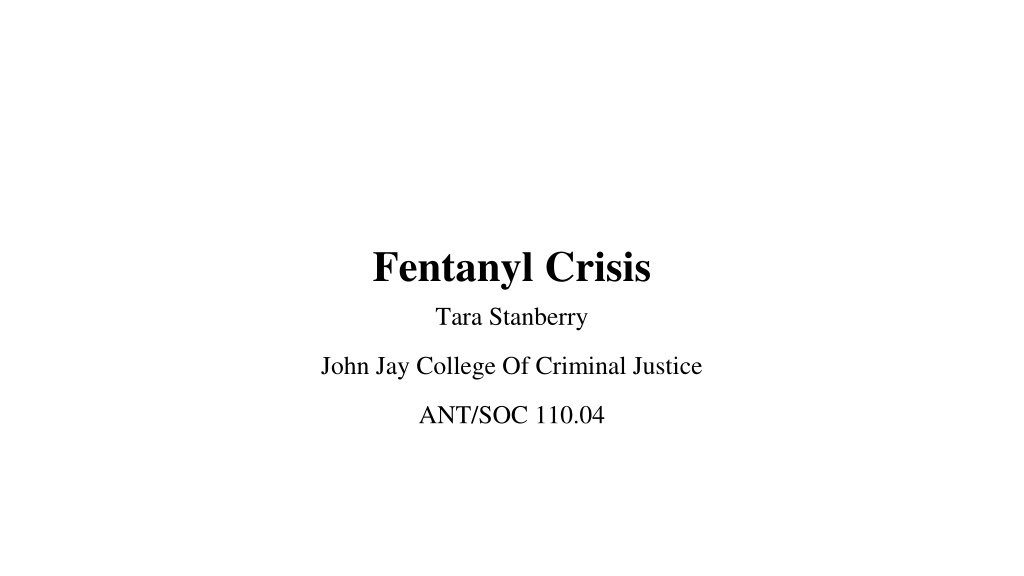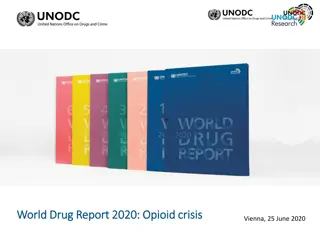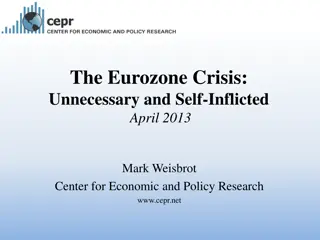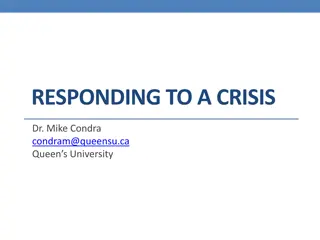Understanding the Fentanyl Crisis: Impacts and Adaptations
The fentanyl crisis, a significant aspect of the opioid epidemic, has led to a surge in overdose deaths, with devastating effects on various demographics. This crisis has prompted shifts in drug policies, healthcare responses, and user behaviors to address the dangers posed by fentanyl-laced substances. By examining disproportionate impacts, perspectives on opioid diversion, and adaptations in the illegal drug market, we can develop more targeted interventions and harm reduction strategies to combat the escalating crisis.
Download Presentation

Please find below an Image/Link to download the presentation.
The content on the website is provided AS IS for your information and personal use only. It may not be sold, licensed, or shared on other websites without obtaining consent from the author. Download presentation by click this link. If you encounter any issues during the download, it is possible that the publisher has removed the file from their server.
E N D
Presentation Transcript
Fentanyl Crisis Tara Stanberry John Jay College Of Criminal Justice ANT/SOC 110.04
Introduction to the Fentanyl Crisis The fentanyl crisis represents a significant evolution in the opioid epidemic, marked by its extreme potency and risk of overdose. Originating as a synthetic opioid for pain management, fentanyl has become a major illicit substance, often mixed unknowingly with other drugs. Since 2013, the United States has seen a sharp increase in overdose deaths attributed to fentanyl, highlighting its deadly impact (Arendt, 2021). This slide examines how fentanyl's rise contributes to escalating opioid fatalities and challenges in drug policy and healthcare responses. Understanding the development and spread of the fentanyl crisis is crucial for implementing effective public health strategies.
Disproportionate Impact on Specific Demographics The fentanyl crisis has not impacted all demographics equally; non- Hispanic urban African Americans are particularly affected. Disparities also appear across different ages, races, and geographic locations, with some areas experiencing more severe outbreaks than others. Such disproportionate impacts raise concerns about underlying socio- economic and racial factors that contribute to vulnerability. Addressing these disparities requires targeted interventions that consider the specific needs and contexts of the most affected communities (Brent & Weiss, 2022). This understanding is essential for developing comprehensive strategies that aim to reduce the number of overdose deaths across all demographics.
Perspectives on Prescription Opioid Diversion Traditionally, opioid diversion, or the unauthorized rerouting of prescription drugs, has been viewed negatively due to its association with substance abuse. Some drug users, however, view diversion as a protective measure against the unpredictability of illicit fentanyl, preferring known dosages of diverted pharmaceuticals (Arendt, 2021). This challenges the conventional perception of diversion solely as a problem, suggesting it might play a role in harm reduction. Effective policy measures should consider the complex reasons behind diversion, balancing prevention of misuse with the need for harm reduction. Insights from users perspectives on diversion can guide more nuanced approaches to opioid policy and education.
Adaptation to the Transformed Illegal Opioid Market As the illegal opioid market increasingly includes fentanyl, users are forced to adapt their behaviors to mitigate risks (Brent & Weiss, 2022). Some users develop methods to discriminate between different substances, such as heroin and fentanyl, to avoid unexpected overdoses. Changes in consumer behavior indicate a shift in drug use patterns, reflecting the broader impact of fentanyl on the illicit drug landscape. These adaptations also have implications for overdose prevention strategies and public health initiatives focusing on infectious disease control. Understanding these shifts is vital for developing effective interventions that address the current realities of opioid use and enhance safety among users.
References Arendt, F. (2021). The opioid-overdose crisis and fentanyl: the role of online information seeking via internet search engines. Health Communication, 36(10), 1148-1154. Brent, J., & Weiss, S. T. (2022). The opioid crisis not just opioids anymore. JAMA Network Open, 5(6), e2215432-e2215432. Bardwell, G., Small, W., Lavalley, J., McNeil, R., & Kerr, T. (2021). "People need them, or else they're going to take fentanyl and die": Mistler, C. B., Chandra, D. K., Copenhaver, M. M., Wickersham, J. A., & Shrestha, R. (2021).























